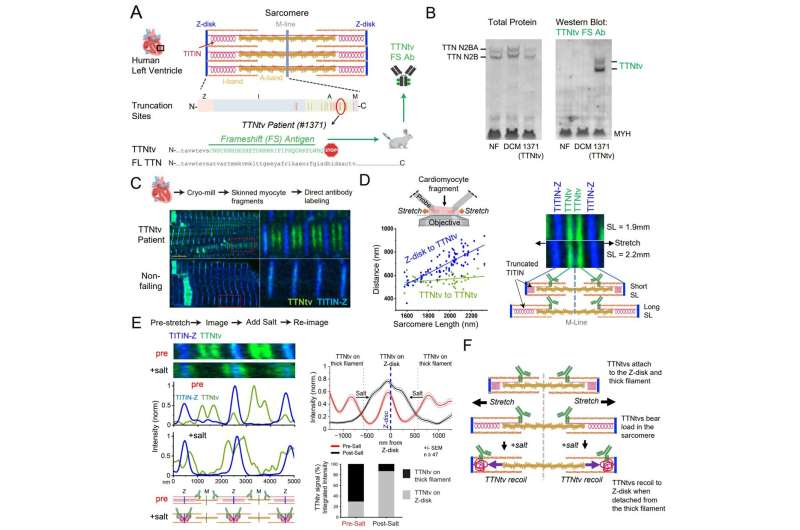This article has been reviewed according to Science X's editorial process and policies. Editors have highlighted the following attributes while ensuring the content's credibility:
fact-checked
peer-reviewed publication
trusted source
proofread
Intriguing insights uncovered for two rare heart muscle diseases

Advancements in the study of two rare heart conditions—peripartum cardiomyopathy (PPCM), and dilated cardiomyopathy (DCM)—contributed by researchers at the Perelman School of Medicine at the University of Pennsylvania may serve as critical guides in future work toward developing therapies for the conditions.
The lab of Zoltan Arany, MD, Ph.D., the Samuel Bellet Professor of Cardiology and a professor of Cell and Developmental Biology, published their findings this month in the New England Journal of Medicine (NEJM), adding to separate research they recently published in the Journal of Clinical Investigation (JCI).
PPCM is a severe cardiac condition affecting approximately 1 in 1,000 pregnant or recently pregnant women, characterized by the weakening of the heart muscle, leading to reduced cardiac function. Certain factors increase the risk of developing PPCM, including advanced maternal age, multiple gestations (twins or more), anemia, and hypertensive disorders of pregnancy.
Black women in the United States are at a much higher risk compared to White women for reasons that remain unclear. Treatment for PPCM generally involves standard heart failure management strategies, including medications like diuretics, beta-blockers, and ACE inhibitors. In severe cases, advanced therapies such as LVADs or heart transplantation may be considered.
Unlike PPCM, DCM can occur at any age, is not specifically related to pregnancy, and affects about 1 in 100 people. Risk factors for DCM can include a family history of heart disease, certain infections, exposure to toxins, and other underlying heart conditions.
The recent JCI study focused on the role of genetic variants in the TTN gene, which encodes for a crucial protein called titin. Titin acts like a spring, playing a vital role in the assembly and regulation of heart muscle contraction.
The study sheds light on how specific genetic variants, known as truncating variants (TTNtvs), in the TTN gene may contribute to DCM. Arany and his team developed a patient-specific antibody to detect these TTNtvs in human heart tissue. Using this novel approach, they found that TTNtvs are present in hearts affected by DCM, indicating a potential link between these genetic variants and the development of the disease.
The study also revealed that the truncated titin proteins associated with TTNtvs integrate into the heart's muscle structure. This suggests that these genetic variants may impact the sarcomere, the basic unit of the heart muscle, influencing its structure and function.
Meanwhile, the recent article in the NEJM consolidates the current state of knowledge about PPCM while providing a roadmap for navigating the complexities of the disease. Past research from the Arany lab has highlighted the racial disparities in PPCM, with Black women in the US being four times more likely than White women to develop the disease.
The NEJM article emphasizes the critical need for early diagnosis and the development of effective management strategies, given that PPCM is now a leading cause of maternal mortality in many parts of the world.
"There is a great need for further research into long-term outcomes, racial disparities, and the underlying mechanisms of PPCM," said Arany. "We hope our recent research signals a call to action for the medical community to address this critical issue affecting young women, their families, and newborns."
There is a profound lack of research on peripartum cardiomyopathy (PPCM), which limits an expert's ability to find the best way to treat and ultimately prevent it. In order to make important discoveries, doctors at the Perelman School of Medicine created PPCM-R, the first patient-focused registry about PPCM. Among the goals of the PPCM-R is to create a database of PPCM survivor medical records driven by patients, to answer important research questions, and ultimately prevent PPCM.
More information: Quentin McAfee et al, Truncated titin protein in dilated cardiomyopathy incorporates into the sarcomere and transmits force, Journal of Clinical Investigation (2023). DOI: 10.1172/JCI170196
Zoltan Arany et al, Peripartum Cardiomyopathy, New England Journal of Medicine (2024). DOI: 10.1056/NEJMra2306667
















